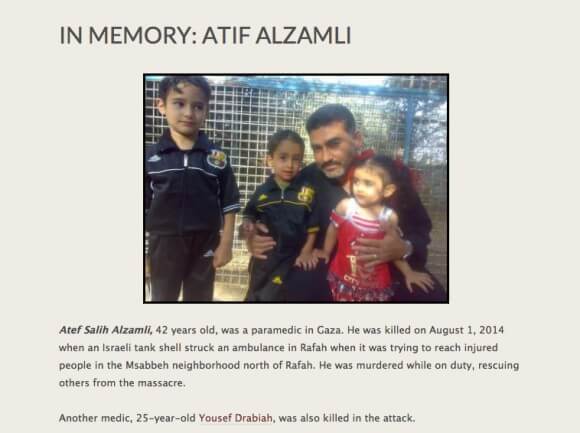
The bodies of Gilad Shaar, Naftali Fraenkel, and Eyal Yifrah, three Israeli settlers, who went missing on June 12th, were found in the West Bank village of Halhoul. The names, ages and pictures of these three Israeli youth quickly circulated all over Western news and social media. We knew what they looked like, who their families were and whether they were good in school or not. Before their bodies were found, the hashtag #BringBackOurBoys was launched as a social media campaign to raise awareness about their kidnapping, mirroring a similar initiative launched earlier this year called “Bring Back Our Girls,” which aimed to increase global awareness of the 230 schoolgirls kidnapped by Boko Haram in Nigeria. Times Square even put up a billboard to call for the safe return of the boys. After their bodies were found, the Times Square billboard changed to mourn the Israeli teens; it read: “we join the families and all of Israel in mourning the tragic loss of these innocent boys.”
Although Hamas denied allegations that they kidnapped and killed the three Israeli settlers, Israel used the kidnappings as a pretext to not only incarcerate 800 Palestinians without charge or trial and raid nearly 1,300 residential, commercial and public buildings in the Occupied West Bank, but to also bomb the Gaza Strip. The attacks on the Gaza Strip, through what is referred to as Operation Protective Edge, killed almost 2,000 people, one-third of whom were children, injured almost 10,000 people, nearly destroyed the infrastructure of a civilized life in Gaza, and displaced close to 500,000 Palestinians since the beginning of the operation on July 8, 2014.
Israel’s indiscriminate bombings and mass killings of whole families reflects its cruel and genocidal tactics. This offensive, however, is not an isolated incident. The barbaric nature of the State is reflective of the broader Zionist settler-colonial project, through its siege on Gaza, confiscation of land, demolition of homes, restriction of movement, and arbitrary imprisonment of Palestinians. Israel has simultaneously constructed itself as part of the ambiguous “West,” alongside the United States and Europe, where colonialism, racism, and imprisonment are inherent to the establishment of the State. Israel defends its policies by painting itself as the “only democracy in the Middle East,” placing itself as exceptional. Western media assists in constructing Israel as a sovereign (read: civilized) state and Palestinians as stateless (read: uncivilized), which allows Israel to justify its actions as “self-defense” while denouncing Palestinian acts of resistance as “terrorism.” Because of these constructions, Western media values Israeli lives over Palestinian lives. The consistent support of the United States for Israel, through both military aid and intelligence and increased censorship of Palestinian voices in the media, has established whose lives may be marked as lives and whose deaths will count as deaths.
We see this in the coverage of the current crisis in Gaza today. Palestinians are portrayed through the media as nothing more than a death toll—a number that is increasing daily. On social media, graphic images of their corpses circulate, reducing Palestinians to burned and mutilated bodies. We don’t know anything about them. Who are they? What is their family history? What were their hobbies? Did they like school? We begin to associate Palestinian bodies with death and disposability. Not only are Palestinian bodies dehumanized, but they are also cast off as unreal. Because Palestinian lives are not constituted as lives, according to Western bias, it is impossible to mourn their deaths. Their lives are not livable and their deaths are not grievable. If Palestinian lives are not seen as lives, then are their deaths even considered real deaths? In her book, Precarious Life, Judith Butler eloquently notes “if violence is done against those who are unreal, then, from the perspective of violence, it fails to injure or negate those lives since those lives are already negated.
Websites such as Humanize Palestine seek to challenge these portrayals of Palestinian dehumanization, created by Western news sources and social media. When a photo is attached to a name, the person no longer becomes just a number. They are essentially revived, and their faces are engrained in our collective memory permanently. Including a person’s full name to photos and information about the town they are from is significant. It is a way to celebrate Palestinian history, culture and humanity in the face of oppression.
In learning details about their lives, and not just their deaths, we see daily acts of Palestinian resistance: the aspiring lawyer, the baker, the painter, the mother of five are all celebrated as their beautiful existence sustains the Palestinian fight for freedom and justice. We connect our common interests and our shared dreams in a way that would have otherwise been impossible. For example, Anas Yousef Qandil, a 17 years old boy who was killed on Saturday July 12, 2014 by an Israeli airstrike in Jabaliya, was awaiting anxiously his final grades from Ahmad al-Shugayri high school to celebrate and had plans to study Education at Gaza’s Islamic University. Anas and I shared a passion for education and aspired to be educators. The sad reality is that his dreams were stripped away from him at such a young age. Humanize Palestine allows us to grieve their deaths and celebrate their lives, by making their lives real to the viewer. By sharing their stories, Palestinians are able to speak for themselves and share themselves with the world- each life commemorated contributing to the ongoing Palestinian resistance movement.


I am reminded of Anthony Bourdain’s words when accepting an award from the Muslim Public Affairs Council:
Thank you for this important truth and best wishes for the enterprise.
Just one quibble –
“Israel has simultaneously constructed itself as part of the ambiguous “West,” alongside the United States and Europe, where colonialism, racism, and imprisonment are inherent to the establishment of the State.”
I don’t see any ambiguity; the “West” enforces its will, as it always has, by violence. ‘Genocide’ is missing from the list. Israel’s actions remind us. No ambiguity.
When Kerry visited the parents of the Jewish Jihadi Carmeli in Jerusalem he told them “I’m in awe of your son.”
For what!? All the dude did was enlist in a foreign army and get himself killed! As far as I am concerned Carmeli did not have one millionth of the courage in his whole body that those Gaza paramdics, medical teams and firefighters have in their little fingers. Doing their jobs while Butcher Bibi’s minions try to kill them. Some people don’t know the meaning of the word hero.